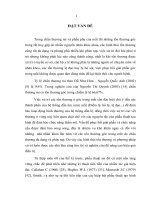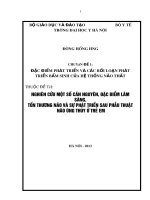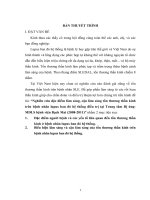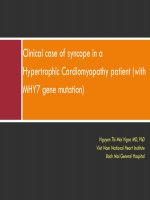Trình bày ca lâm sàng tổn thương chỗ chia đôi
Bạn đang xem bản rút gọn của tài liệu. Xem và tải ngay bản đầy đủ của tài liệu tại đây (852.87 KB, 18 trang )
Bifurcation Case
What to do next??
Bifurcation stenting:
Questions to be answered
Types of
bifurcations
Two
stents or
one?
Should I
have kissing
stents?
What is plaque
shifting?
What
Technique..
IVUS/OCT…?
What did we do
Why do that???
2. Dedicated Devices:
Pros:
- Effective treatment of entire bifurcation
anatomy.
- Minimal main branch impact.
Cons:
- Cost (price and time) since 2 stents
required.
- More complex design than modified
provisional.
Current Stent Design Options
(Provisional).
While simple in concept they fail to
deal with the complexity of the
anatomy.
Current Stent Design Options (Dedicated)
Current Stent Design Inputs
Their simplicity lies in their ability to treat the complexity
of the anatomy in a repeatable and effective way.
Goal: Span Both Vessels
Cover the proximal lesion segment
Cover the ostium of the side branch and distal parent vessel without
compromising access to the side branch
This is accomplished if 2 markers are in 1 branch and 1 is in the other
Provide a convenient placement marker for additional distal stents
Angiographic Outcome
Any in-bifurcation restenosis:
6.4% (9/140 at 9 months)
(DIVERGE Study)
Location Analysis:
Proximal edge:
2.8%
SB stent:
4.8%
(105 SB stents)
Parent Vessel RS 2 pts
3 pts Both
Side Branch RS
4 pts
Lowest restenosis rates
ever reported in a bifurcation
study of any kind
AXXESS:
0.7%
Distal PV Cypher:
2.1%
Dr. Grube, Bangkok 2012









